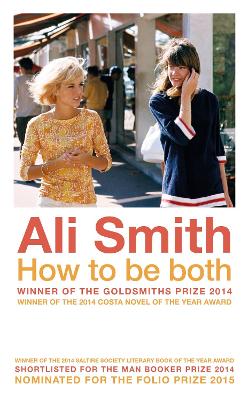Reviewed by pamela on
If there is one thing Ali Smith's Bailey's Prize Victory with her novel 'How To Be both' has proven to me it is that even literary prizes can fall prey to the bells, whistles and buzz words of a good media campaign.
'How To Be Both' was marketed as a genre defining, genre bending and genre creating novel of ultimate importance in the literary world. It hailed the rebirth of true stylistic originality, and Ali Smith has been described by one of the Bailey's Prize judges Shami Chakrabarti as 'a literary genius'. The problem is, I don't know a single person who liked it.
The novel's main selling point is that it can be read in two different ways. We have a modern story about a teenager in Cambridge named George, and a story about Renaissance painter Francesco del Cossa. Depending on which copy of the book you pick up will depend on which story you are treated to first. The order in which each half is read is supposed to change the entire reading experience. From discussion with my book group a few weeks ago we deduced that yes, it did change the reading. But only those who read Francesco's story first derived any semblance of enjoyment from 'How To Be Both', and indeed seemed to understand the underlying a plot a lot better. Francesco's story is stylistically more complicated to follow, and is without a doubt less interesting than George's half. Reading George's story second seemed to feel like a reward, whereas having to read Francesco's half second felt like the ultimate punishment. Francesco's half was rather more abstract that George's, and this abstraction lent itself to understanding only if read first. Upon discussion we found that those of us who had read Geroge's story first simply did not put the connection between the two characters together, meaning we ultimately felt that we'd read two different stories rather than a cohesive whole. To me this would indicate that the central selling point of this novel's originality was ineffectual and I must admit I'm not even entirely convinced of its intrinsic originality. I feel like we are meant to see this as new and revolutionary for no other reason than Ali Smith told us to. Huge props to her publicist who deserves a raise for making us all believe it.
The pages devoted to Francesco's story in 'How To Be Both' are stylistically experimental. They flow poorly and are not written in a style believable to the settings time period. Ali Smith has also made an annoying decision to replace the word 'because' with 'Cause' in every case within Francesco story. It truly grated after a while, and did not serve to heighten the plot, or give Francesco a convincing voice. Smith also foregoes the use of regular grammatical structure, something that I don't usually take issue with when implemented to the advantage of a novel. In this case however it felt like a self conscious decision to appear to be 'literary'. It is a plot device employed in what feels like a cynical move to appeal to the pretensions of judges who sit on literary prize panels. Do they make decisions of the merit of a work, or do they make decisions based on the fact that they, like everyone, gets so caught up in the supposed newness of an idea that they see a genius that simply isn't there because they so desperately want it to be?
I know that I am not alone in seeing Ali Smith's 'How To Be Both' as far from the genius it has been claimed to be. I think what we have now is a large proportion of the reading public who are too worried about coming across as ignorant, or that they somehow just didn't get it. So they smile, nod and perpetuate the marketing jargon which makes us all think that 'How To Be Both' is the second coming of the novel, all so that their supposedly 'more learned' friends won't think them stupid. In my opinion there are a whole lot of disappointed book buyers out there who have spent good money on something that they were told was going to be brilliant and ultimately left them a little more empty than before they'd read it. It is simply a case of the literary marketing monster desperately making us want a thoroughly underwhelming product. Did I buy it? Yes I did. Did I enjoy it? I think the answer to that is obvious.
http://iblamewizards.com/opinion-how-to-be-both-wins-the-baileys-prize/
Reading updates
- Started reading
- 24 May, 2015: Finished reading
- 24 May, 2015: Reviewed
